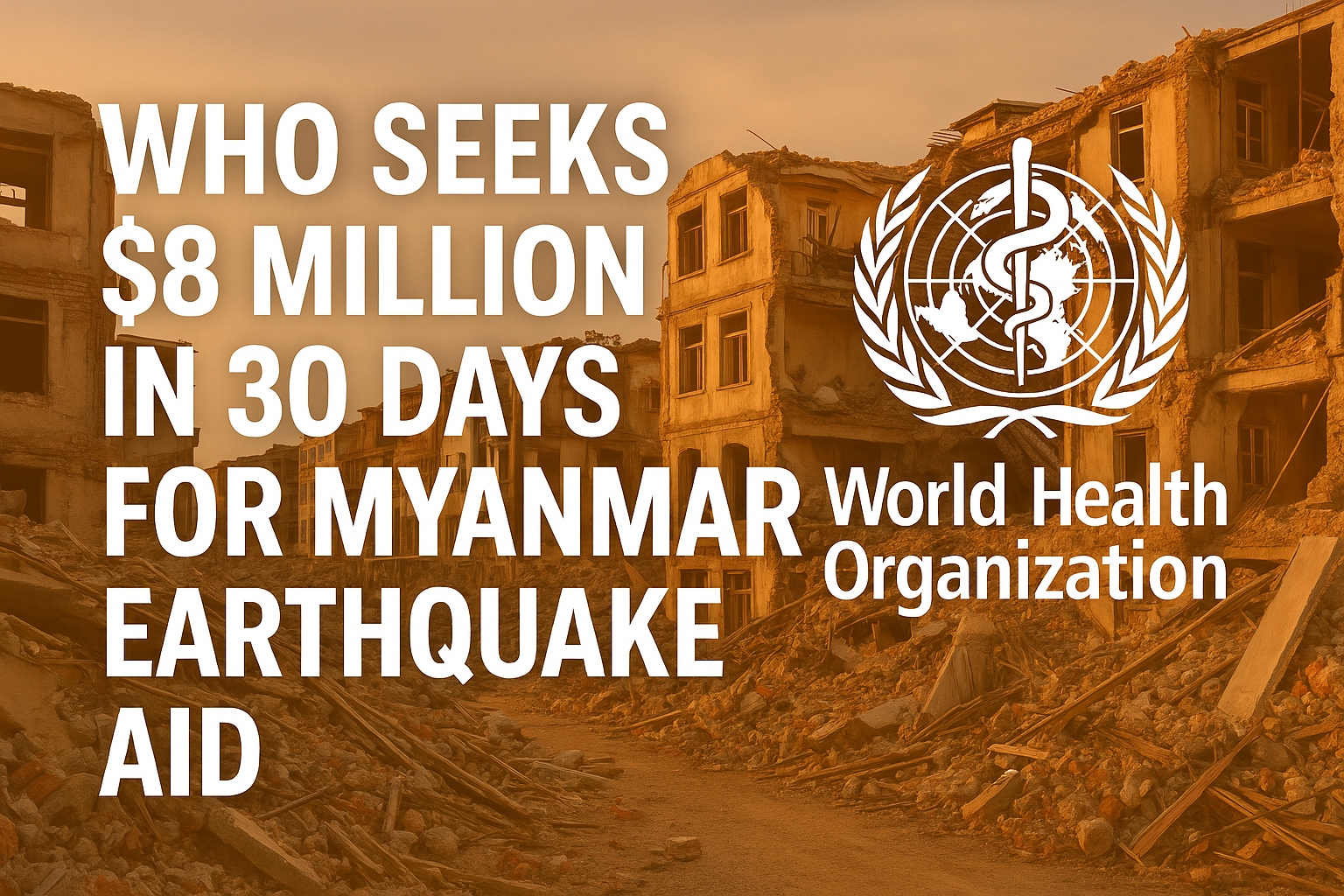In the wake of a devastating earthquake that recently struck Myanmar, the World Health Organization (WHO) has launched an urgent appeal, requesting $8 million within the next 30 days to support emergency relief operations. This funding will be dedicated to delivering life-saving healthcare and humanitarian assistance to thousands affected by the catastrophe.
The 6.0-magnitude earthquake that rattled southeastern Myanmar led to extensive structural damage, worsened the ongoing public health crisis, and displaced countless families—all while the country contends with political instability and limited resources. WHO’s rapid funding appeal emphasizes the urgent need for international solidarity to prevent disease outbreaks and reduce suffering during this critical time.
Myanmar’s Health Crisis Deepens
The current disaster exacerbates an already complex situation. Years of conflict, the lingering impact of the COVID-19 pandemic, and underfunded health services have left the people of Myanmar particularly vulnerable. With hospitals damaged and access to medical aid severely limited, the earthquake has delivered a devastating blow to an already failing healthcare infrastructure.
Dr. Saima Wazed, WHO’s Regional Director for South-East Asia, spoke about the situation, saying,
“We cannot delay. Lives are at stake. We must act decisively and urgently to ensure that those affected receive the medical care and resources they desperately need.”
Key Challenges on the Ground
Since the earthquake, WHO has been working closely with Myanmar’s Ministry of Health and various local partners to conduct rapid health assessments. However, the reality on the ground presents serious challenges:
- Destroyed health facilities: Many healthcare centers in the earthquake-affected region are non-functional due to structural damage.
- Lack of clean water & sanitation: Increased risk of water-borne diseases threatens to magnify the health crisis.
- Displaced communities: Thousands are now homeless and in urgent need of shelter, food, and medical care.
- Limited access to medical supplies: The need for vaccines, antibiotics, diagnostic equipment, and emergency obstetric care is critical.
Where the $8 Million Will Go
The funds that WHO is seeking will go toward comprehensive emergency support. The goal is to provide essential healthcare to more than 220,000 individuals directly affected by the disaster. Here is how the proposed allocation will break down:
- Emergency kits: Distribution of WHO-approved Interagency Emergency Health Kits (IEHKs) to treat common illnesses and minor injuries.
- Mobile health teams: Deployment of on-the-ground medical professionals to reach remote and cut-off communities.
- Surveillance and early warning systems: Setting up disease monitoring to prevent outbreaks like cholera, malaria, or dengue.
- Mental health support: Addressing trauma and psychological stress from the disaster and displacement.
- Safe maternal care: Support for pregnant women and newborns through emergency obstetric care units.
Why Quick Action is Crucial
Every day without assistance means more preventable illness, suffering, and even death. While international focus may at times drift away from smaller nations in crisis, Myanmar’s situation should not be seen in isolation. Public health emergencies—especially in politically fragile regions—can have cascading consequences that reach beyond national borders.
According to WHO, delays in financing humanitarian operations often lead to:
- Increased outbreaks of preventable diseases like cholera, respiratory infections, or typhoid.
- Disrupted routine health services, resulting in unaddressed chronic illnesses or maternal/child mortality.
- Reduced efficiency in aid delivery due to dwindling resources and logistic constraints.
- Prolonged recovery periods that can take years to mend, even with future support.
WHO’s Track Record in Emergency Response
This isn’t the first time WHO has responded to a large-scale crisis. With decades of experience in conflict zones, natural disasters, and humanitarian emergencies, WHO is uniquely positioned to deliver rapid and impactful intervention. WHO typically works in coordination with:
- The United Nations Office for the Coordination of Humanitarian Affairs (UNOCHA)
- Medical NGOs such as Médecins Sans Frontières (MSF)
- Community health workers trained to support long-term health resilience
Their coordinated response ensures that funds are utilized effectively, with minimal administrative overhead, and maximum reach.
You Can Be Part of the Solution
Even though the WHO appeal is directed primarily at international donors and governments, individual contributions—no matter how small—can have a major impact when pooled collectively through partner NGOs.
Here are a few meaningful ways to help:
- Donate: Support global or local NGOs aligned with WHO’s emergency response in Myanmar.
- Raise awareness: Share credible news and campaigns on your social platforms.
- Fundraise: Organize virtual events, donation drives, or workplace giving campaigns.
- Advocate: Contact your representatives or policymakers to support foreign aid for emergencies like this.
Conclusion: A Critical 30-Day Window
The clock is ticking. WHO’s call for $8 million within just 30 days is not a suggestion—it is a survival imperative for hundreds of thousands in Myanmar. The region’s fragile healthcare system and vulnerable populations are on the brink of an even greater disaster if immediate assistance does not arrive.
The situation demands more than sympathy; it requires swift and united global action. Every dollar raised and every voice raised in support can make a difference.
Let us hope that the world answers this call—not just with thoughts and prayers, but with concrete actions that restore dignity, health, and hope to those who have lost so much.
Stay Informed & Get Involved
For updates on this crisis and how to contribute to WHO’s emergency fund:
- Visit the official WHO website
- Follow WHO on social media for real-time developments
- Spread awareness through blog posts like this one
Together, we can shine a light where it’s needed most.


